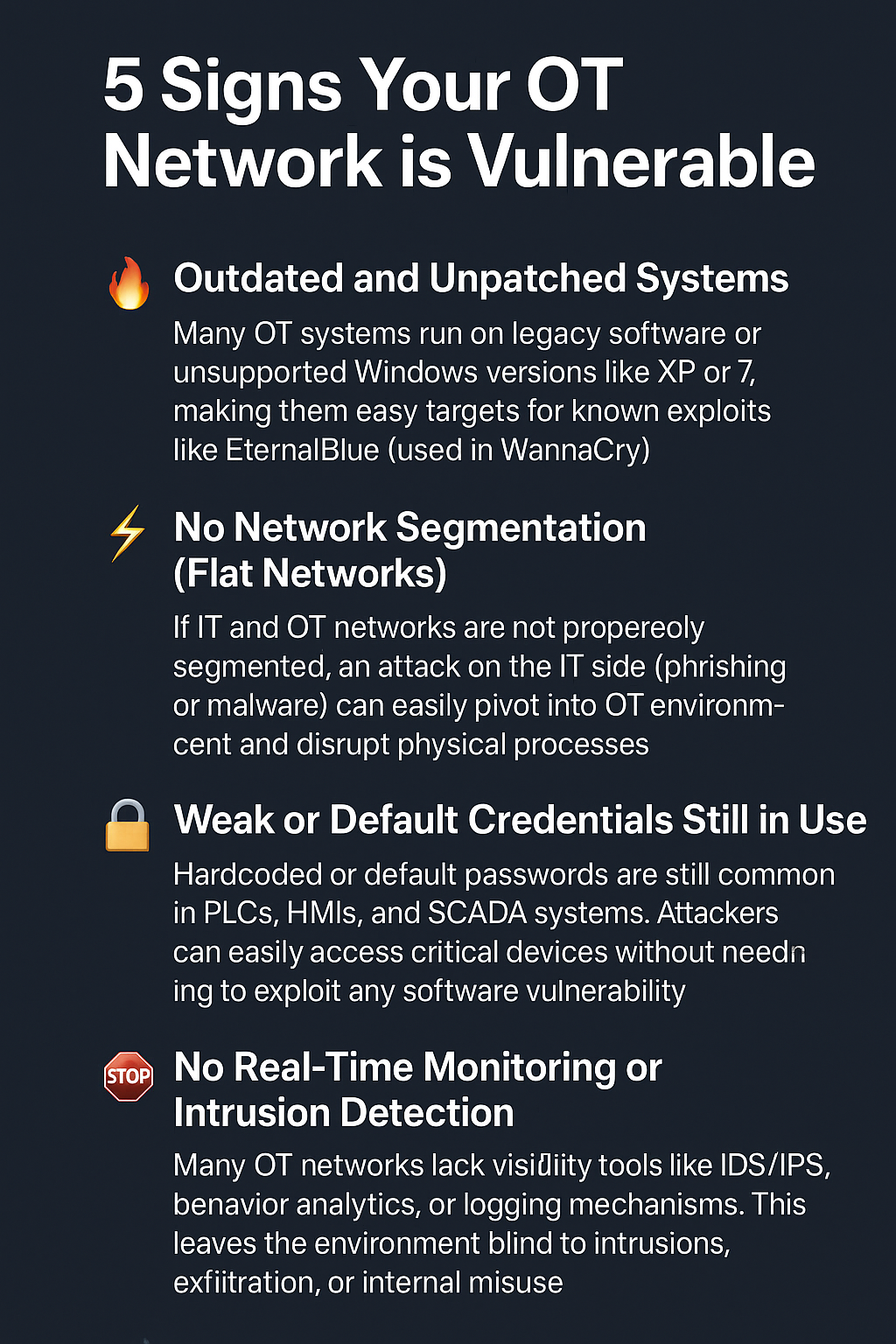5 Signs Your OT Network is Vulnerable

⚠️ 1. Outdated or Unpatched Systems
Many OT devices run on legacy systems like Windows XP, Windows 7, or unpatched firmware — which are no longer supported or updated by vendors. These systems are low-hanging fruit for attackers, as publicly known exploits can easily be used against them.
Real-World Example:
- WannaCry ransomware exploited a known Windows vulnerability (EternalBlue) and affected many SCADA systems worldwide.
Recommendation:
- Conduct regular patch assessments. If patching isn’t possible, use virtual patching, firewall rules, or application whitelisting.
???? 2. No Network Segmentation (Flat Architecture)
If your OT and IT networks are on the same flat network, a compromise in IT (via phishing, malware, or an infected USB) can easily propagate into OT, impacting physical devices like PLCs, sensors, or HMIs.
Threat Example:
- EKANS Ransomware was designed to specifically target ICS/SCADA by disabling OT-related processes.
Recommendation:
- Create strong network segmentation using VLANs, firewalls, and DMZs between corporate IT and OT environments.
???? 3. Default or Weak Credentials
It’s shocking how many OT systems still use default logins like admin/admin or root/1234. Many PLCs and RTUs are deployed with weak authentication — or none at all.
Real Threat:
- Attackers use automated tools to scan for devices with default credentials, gaining access without triggering any alerts.
Recommendation:
- Implement a strict password policy, enforce MFA, and eliminate all default or shared credentials.
????️ 4. No Real-Time Monitoring or Logging
If you’re not monitoring your OT traffic, you’re flying blind. Lack of visibility means you won’t even know you’ve been breached until it’s too late.
What You Might Miss:
- Suspicious commands over Modbus/DNP3
- Firmware tampering
- Internal misuse or misconfigurations
Recommendation:
- Deploy OT-aware monitoring tools like Nozomi Networks, Dragos, or Claroty.
- Enable centralized logging and alerts through SIEM or ICS-focused platforms.
???? 5. Insecure Remote Access
OT engineers often need remote access to control systems, but insecure methods like open RDP, outdated VPNs, or even dial-up modems are still in use — creating a direct backdoor for attackers.
Case Study:
- The Colonial Pipeline ransomware incident began with stolen VPN credentials.
Recommendation:
- Use secure VPNs with MFA, jump servers, and strict access control lists (ACLs). Audit remote access logs regularly.
Related Post
 08
08 jun
DHS issues emergency directive to prevent hacking attack
Lorem ipsum, dolor sit amet consectetur sit adipisicing Consectetur nisi pariatur quos.
Read More 09
09 jun
Drughydrus Add Google Drive To Roughrobin Torjan
Lorem ipsum, dolor sit amet consectetur sit adipisicing Consectetur nisi pariatur quos.
Read More